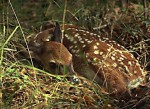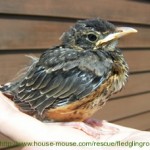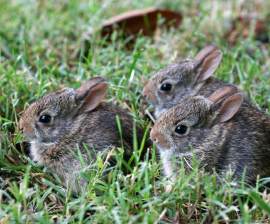 It is baby time in the wildlife world! From white-tailed deer fawns to fledgling sparrows, babies seem to be popping up everywhere. And with all this activity inevitably comes human-wildlife interaction. Although accidents happen, i.e., collisions with cars, feral animal attack, etc., that leave wildlife young orphaned, sometimes alone doesn’t really mean alone. It is very common that wildlife parents simply leave their babies while they are hunting or foraging only to return later. In addition, if parents are startled they may temporarily lose their infants. So what is the best course of action if a baby animal is found?
It is baby time in the wildlife world! From white-tailed deer fawns to fledgling sparrows, babies seem to be popping up everywhere. And with all this activity inevitably comes human-wildlife interaction. Although accidents happen, i.e., collisions with cars, feral animal attack, etc., that leave wildlife young orphaned, sometimes alone doesn’t really mean alone. It is very common that wildlife parents simply leave their babies while they are hunting or foraging only to return later. In addition, if parents are startled they may temporarily lose their infants. So what is the best course of action if a baby animal is found?
The power of observation is perhaps the strongest tool we have in crisis aversion. If you find wildlife young alone in a safe place simply watch it from a distance to see if the parents come back. This reclaiming may be something that takes five minutes or several hours, but it is best to wait it out before physically making contact with the baby. However, if you find a baby in a roadway or taken from the jaws of a a dog or cat it is best to put it in a comfortable, dark place and contact a professional such as a wildlife rehabilitator, veterinarian, or wildlife official. At this point I should also mention two important side notes: 1. Please make sure that you are not endangering yourself in the process of saving wildlife and 2. Babies found on roads are not necessarily orphans as it is possible they were traveling with parents. The best thing to do is move young off the side of the road and wait. When all else fails, use your best judgment.
wildlife young alone in a safe place simply watch it from a distance to see if the parents come back. This reclaiming may be something that takes five minutes or several hours, but it is best to wait it out before physically making contact with the baby. However, if you find a baby in a roadway or taken from the jaws of a a dog or cat it is best to put it in a comfortable, dark place and contact a professional such as a wildlife rehabilitator, veterinarian, or wildlife official. At this point I should also mention two important side notes: 1. Please make sure that you are not endangering yourself in the process of saving wildlife and 2. Babies found on roads are not necessarily orphans as it is possible they were traveling with parents. The best thing to do is move young off the side of the road and wait. When all else fails, use your best judgment.
So now what happens when you have either confirmed that a wild animal parent has been killed or has truly lost their baby? As odd as it sounds, you do as little as possible. Caring for wildlife, be it injured or orphaned, should only be done by trained professionals. As a licensed rehabilitator, I have lost track of how many times good intentions resulted in the death of the animal someone was trying to save. Regardless of situation, animals will be stressed. The first thing to do is safely get the animal in a box or pet carrier. Place the animal in a dark, quiet area and call a professional. If the animal cannot safely be handled continue to watch the animal while a professional is called. The last thing you want to do is get injured yourself or further injure the animal. At no time should milk, water, or food be offered.
In my own experience, few people know who to call in a wildlife emergency. Most states have wildlife hotlines or lists of wildlife rehabilitators who can help by giving advice or will pick the animal up for evaluation and/or medical attention. These individuals are trained in wildlife first-response and are licensed to handle animals. In addition, there are also veterinarians that care for wildlife emergencies. Information regarding rehabilitators can be readily available online or in your local phonebook.
wildlife hotlines or lists of wildlife rehabilitators who can help by giving advice or will pick the animal up for evaluation and/or medical attention. These individuals are trained in wildlife first-response and are licensed to handle animals. In addition, there are also veterinarians that care for wildlife emergencies. Information regarding rehabilitators can be readily available online or in your local phonebook.
 Accidents are prone to happen. Get familiar with your state organizations and persons that help wildlife. Be aware and on guard to animal movement around your house and on roadways this time of year. And remember, there is certainly a fine line between rescuing and kidnapping. Please be actively involved and help when you can by observing from a distance and contacting a professional.
Accidents are prone to happen. Get familiar with your state organizations and persons that help wildlife. Be aware and on guard to animal movement around your house and on roadways this time of year. And remember, there is certainly a fine line between rescuing and kidnapping. Please be actively involved and help when you can by observing from a distance and contacting a professional.
